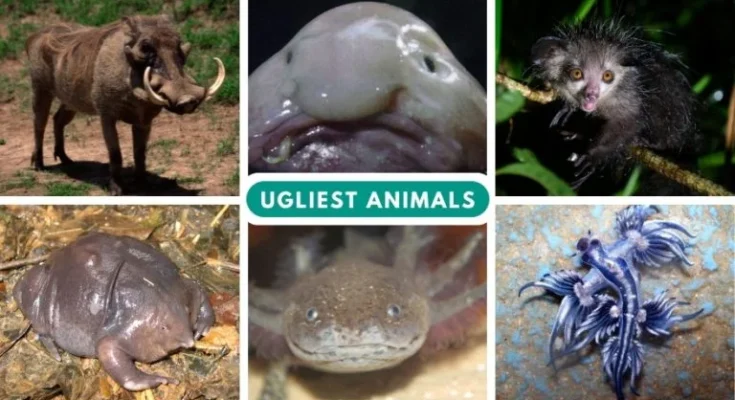We love animals, especially the ones that look cute. From domestic pets to wildlife, animals that won the genetic lottery seem to get the lion’s share of attention, love, and admiration.
Beauty is everything for these animals and their enthusiasts. On the other end of the spectrum are animals you may not fancy looking at.
These creatures fall in the category of the world’s ugliest animals, and while we do say that beauty is in the eyes of the beholder, ugly animals lack what would make them pleasant to the eyes.
All hope is not lost, however, as they still have qualities that make them stand out.
Ugly animals include the warthog, yeti crab, blobfish, and axolotl. What unites them is their physical nature, but other than that, they have their uniqueness.
Read on for a full curated list, pictures, and more detail.
The Ugliest Animals In The World
1. Warthog
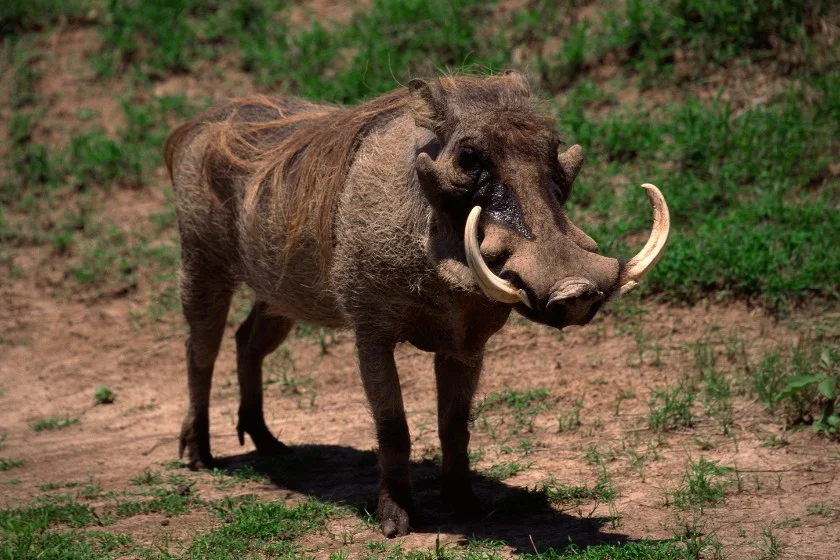
- Scientific Name: Phacochoerus africanus
- Where Found: Africa
- Conservation Status: Least Concern
The first animal on our list is fully known as the common warthog, and it is a member of the Suidae or pig family.
It often inhabits the grassland, savannah, and woodlands of Sub-saharan Africa. You can easily identify this animal with the two tusks protruding from the mouth and moving upwards.
The Warthog is considered the ugliest member of the pig family, with a head that has warty-like elements all over it.
While the warthog Pumbaa in Lion King looks admirable, that is not an accurate description of the animal.
These animals live in groups called sounders and are not known to be territorial. Males only fight or get aggressive during mating season, but other than that, they flee more.
They feed on insects, fungi, eggs, and even carrion, making them omnivorous.
Best places to see the Warthog:
- Sub-saharan Africa
2. Blobfish
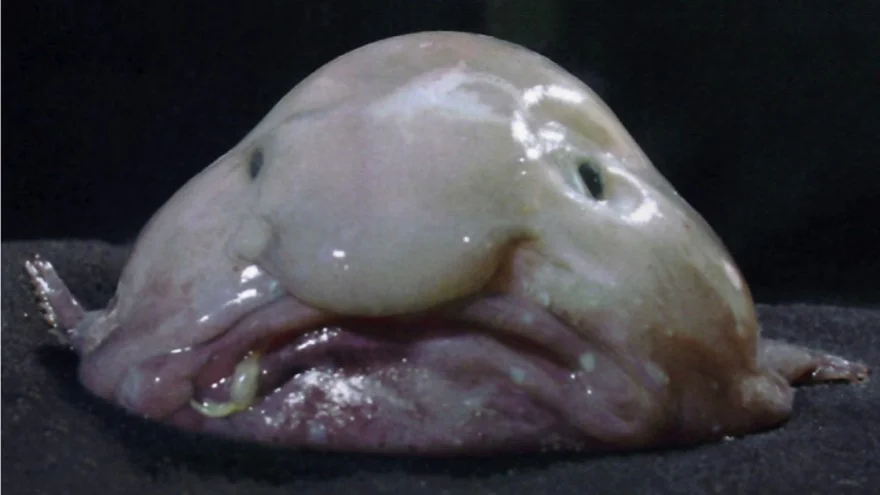
- Scientific Name: Psychlorutes marcidus
- Where Found: New Zealand
- Conservation Status: Not extinct
Not only is the blobfish the ugliest fish in the world, but the blobfish is also considered the ugliest animal on earth, and not in a derogatory manner.
Also known as the smooth-head blobfish, it can be found in deep waters off the coasts of mainland Australia, Tasmania, and the waters of New Zealand.
People often think of it as slime rather than actual fish because of its looks.
Blobfish live in the deep, going down to 600 and 1200m beneath the surface. It lacks muscles, which contributes to its looks.
The lack of muscles isn’t a disadvantage, however. The lack of muscles helps it grab its meal, which comprises mainly of deep-ocean crustaceans.
In 2013, the blobfish was voted the mascot of the Ugly Animal Preservation Society, a position that earned it the title of ugliest animal in the world.1
Best places to see the bluefish:
- Deep waters of Australia;
- Tasmania;
- New Zealand
3. Yeti crab
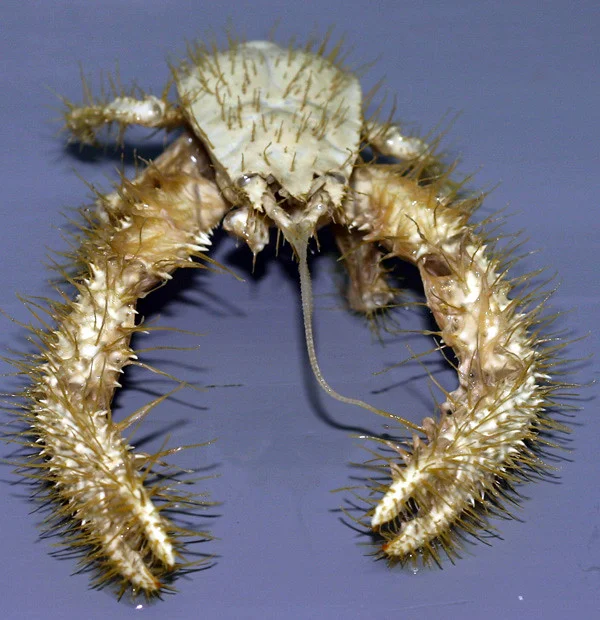
- Scientific Name: Kiwa hirsuta
- Where Found: South Pacific Ocean
- Conservation Status: Unknown
The yeti crab was first discovered in March 2005 by a group of scientists at the California Monterey Bay Aquarium Research Institute (MBARI).
Notable names include Robert Vrijenhoek and Michel Segonzac. Its scientific name Kiwa is from a Polynesian god of the same name. The discoverers also gave it English names.
The yeti is considered unappealing because of the large amount of hair on its skin, but the feature is necessary for it to survive in its habitat.
It lives in the deep, dark parts of the ocean, going down to 2,200 meters. Eyes are not needed there, so the yeti is blind. In place of the eyes, it has a leathery membrane.
The hairs look fluffy, but in reality, they are made of bristles. These bristles help the yeti navigate the deep oceans as they pick up sensory information. They also purify the water around the yeti.
Best places to see the yeti crab:
- South Pacific Ocean
4. Axolotl
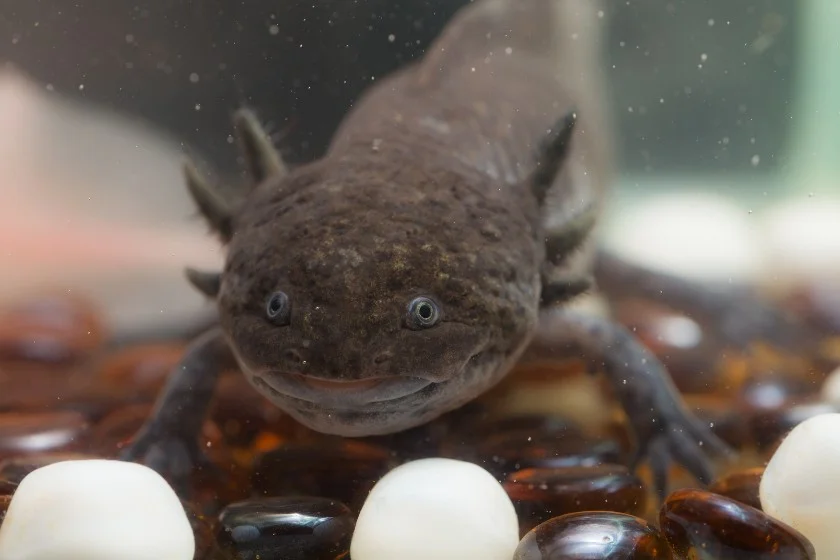
- Scientific Name: Ambystoma mexicanum
- Where Found: Mexico City
- Conservation Status: Critically Endangered
The axolotl is a salamander amphibian closely related to the tiger salamander, and one of its special qualities is the ability to reach adulthood without going through a process of metamorphosis.
They also do not get terrestrial but rather remain aquatic. This falls under neoteny.2
Like others on the list, the axolotl is both strange and ugly. It has a wide head, the eyes are without lids, and the limbs look underdeveloped.
The colors are also strange due to the pigmentation genes the axolotl has. These genes make it become leucistic, a golden albino, a normal albino, and a xanthic color (grey color with black eyes).
The axolotl has a relatively long lifespan, with some individuals getting up to 25 years. Males and females are very common. The only noticeable difference is the cloaca. Males have a more pronounced one.
Best places to see the axolotl:
- Lake Xochimilco, Mexico City
5. Indian Purple Frog
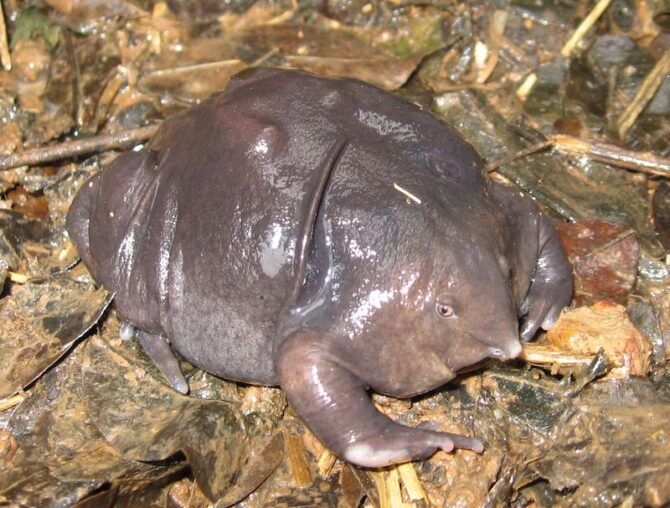
- Scientific Name: Nasikabatrachus sahyadrensis
- Where Found: India
- Conservation Status: Endangered
The Indian purple frog is also called the pignose frog or the purple frog, and it is a rare amphibian that can only be found in India.
It can hardly be seen because it lives underground and because of its endangered status.
The only time these creatures stay above ground is during mating season. If you do come across one, you may not like the look.
The Indian purple frog doesn’t look like a standard frog. With its bloated skin and round form, it seems even less of an animal and more like a bad eggplant.
Its small head and pointed snout add to the overall unusual looks of the Indian purple frog.
The appearance doesn’t stop people from considering it a recipe along its range, but that’s usually during its tadpole stage.
Best places to see the Indian purple frog:
- Western Ghats, India.
6. Monkfish
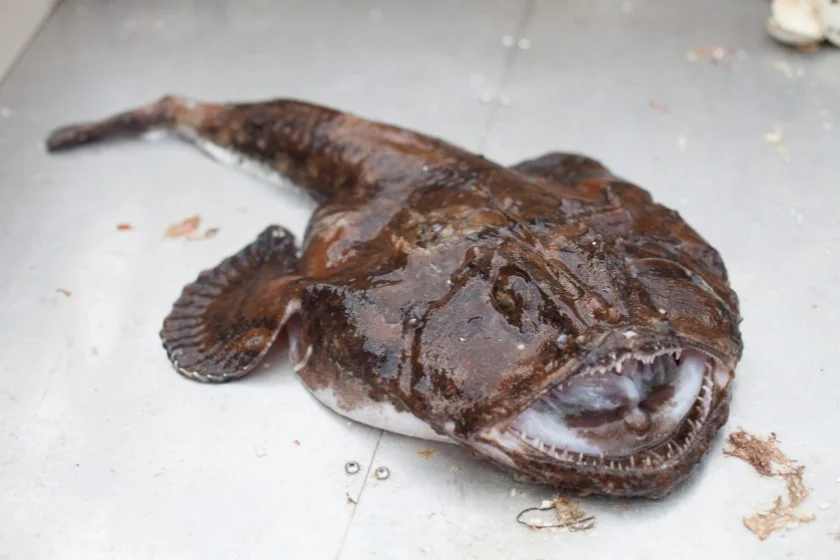
- Scientific Name: Lophius
- Where Found: Atlantic and Indian Oceans
- Conservation Status: Not extinct
The monkfish refers to creatures in the Lophius genus, and they also go by other names like frogfish, fishing frog, and sea devils.
The monkfish inhabits the Indian and Atlantic oceans, going as deep as 3,000 meters. A very unique feature of the monkfish is an organ that shows light, which it also uses to find a mate and trap prey.
A combination of different physical traits makes the monkfish a good candidate for this list. It has a big, flat head that’s also depressed.
Added to this are a big mouth and a jaw filled with long teeth. The jaw and teeth are hunting weapons that it uses to swallow prey.
A fun fact about the monkfish is that the male merges with the female during mating.
Best places to see the monkfish:
- Newfoundland
- North Carolina
7. Japanese Spider Crab
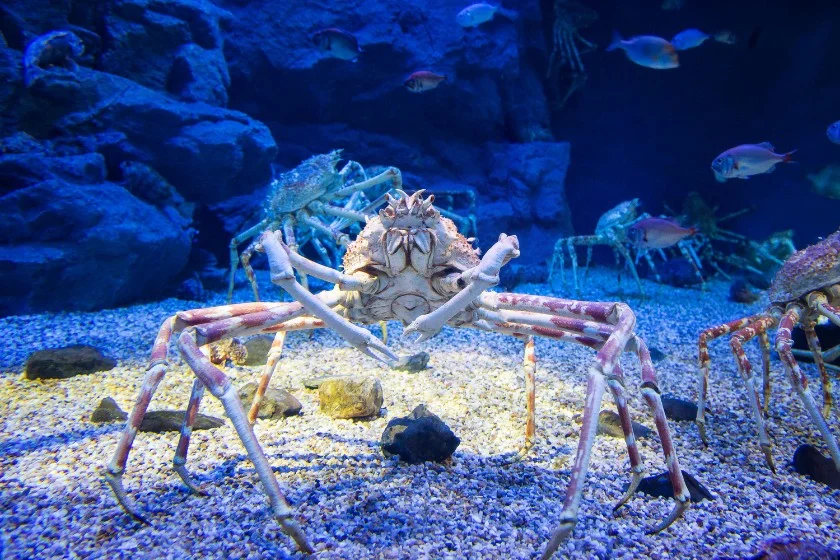
- Scientific Name: Macrocheira kaempferi
- Where Found: Japan
- Conservation Status: Not evaluated
The Japanese spider crab is a marine crab that lives in Japan, and among arthropods, it has the longest legs.
While it has not yet been evaluated by the IUCN, there have been concerns as the population seems to be declining due to overfishing and the destruction of the habitat.
Crabs are not known to be cute, but the Japanese spider crab is ugly even by crab standards. Its long legs, orange and white colors, and rough looks give it a ferocious appearance.
However, the Japanese spider crab is known to be gentler in behavior than its looks suggest. It is a part of the Japanese recipe and can even be found in some fisheries.
Best places to see the Japanese water crab:
- Pacific side of Japan
8. Dumbo Octopus
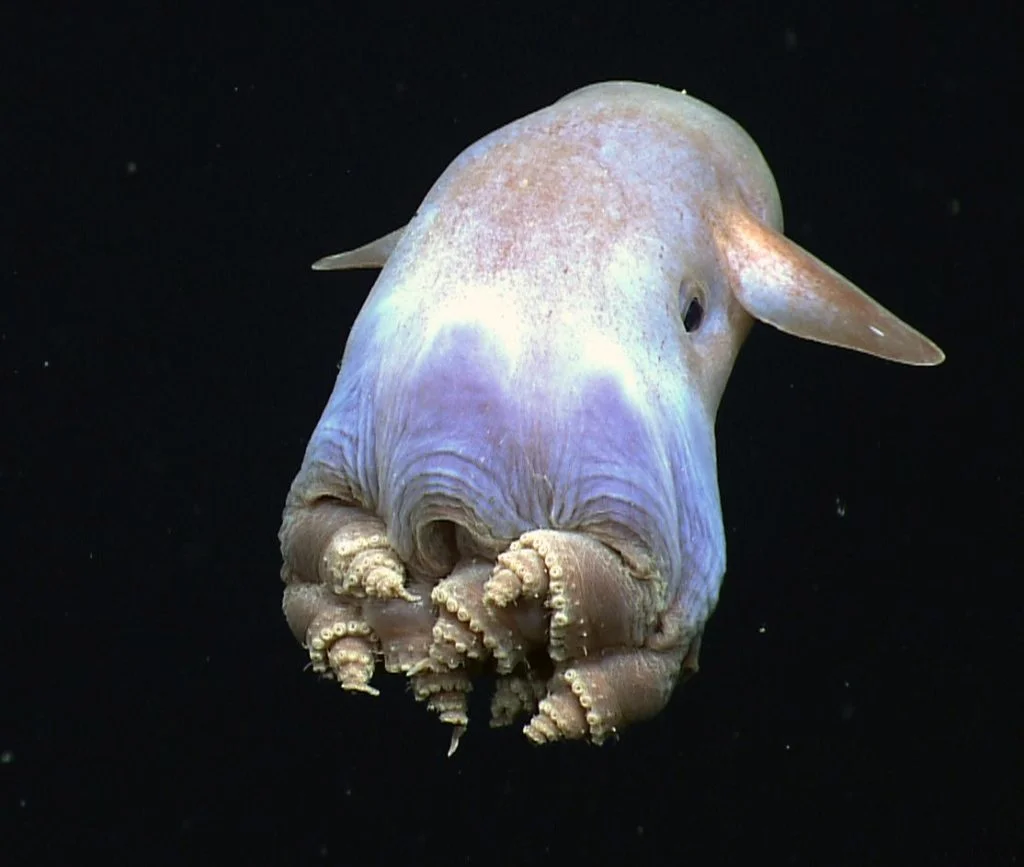
- Scientific Name: Grimpoteuthis
- Where Found: Worldwide
- Conservation Status: Not extinct
The dumbo octopus refers to a group of octopuses that falls under the genus Grimpoteuthis, and its name is inspired by an old Disney film of the same title. There are 17 species of the dumbo octopus.
Unlike the aforementioned animals, some people might consider the dumbo octopus as cute.
However, the unusual elephant look isn’t pleasant to a majority. It is rarely seen, however, because of how deep in the ocean it stays.
This could also be why it has poor eyesight. The dumbo octopus navigates its environment using other senses.
This creature is usually colored red, brown, or even pink.
Best places to see the dumbo octopus:
- The depth of the Indian Ocean
9. Star-nosed Mole
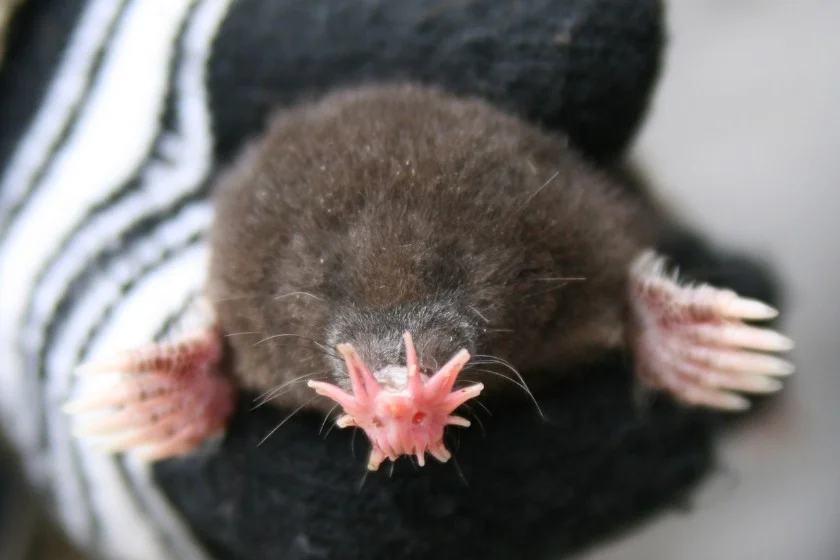
- Scientific Name: Condylura cristata
- Where Found: North America
- Conservation Status: Least Concern
The star-nosed mole can only be found in the northern parts of North America, where it inhabits moist areas.
It can specifically be found in Canada and the northeastern areas of America. It is known to have a lot of sense receptors—getting up to 25,000—all in-touch organs known as Elmer’s organs.3
The star-nosed mole looks monstrous and scary, what with its tentacles that stand in place of muzzles.
We’re not sure if it knows how it looks, but it does move fast, like it doesn’t want to be noticed.
The human eye will find it difficult to track it down. It also eats fast. It can live on land as much as water.
Best places to see the star-nosed mole:
- Canada and the northeastern United States
10. Naked Mole Rat
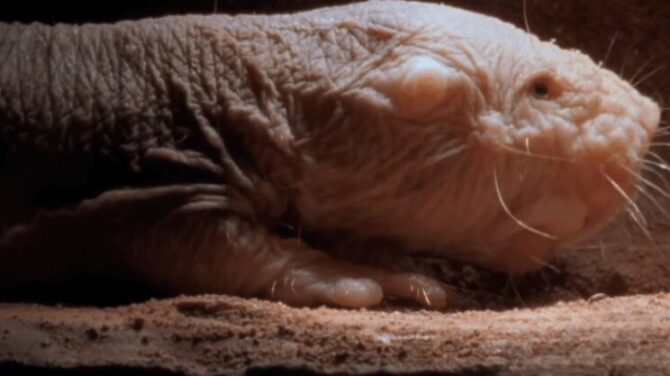
- Scientific Name: Heterocephalus glaber
- Where Found: Africa
- Conservation Status: Least Concern
The naked mole rat looks naked, just as its name implies. Its skin may not bother some people, but to many others, it is unattractive.
The nakedness is due to an absence of hair, leaving only pink and yellow skin. The naked mole rat is also called the sand puppy, and it belongs to the genus Heterocephalus.
This creature shares many similarities with other mole rats, including the ability to live underground and poor eyesight.
Of course, it doesn’t rely on the latter as it has other traits it needs to survive in its environment. These include the large protruding teeth, lips, and jaws.
Best places to see the naked mole-rat:
- East Africa, places like Kenya, Ethiopia, and Somalia.
- San Diego zoo Animals & Plants
11. Aye-aye
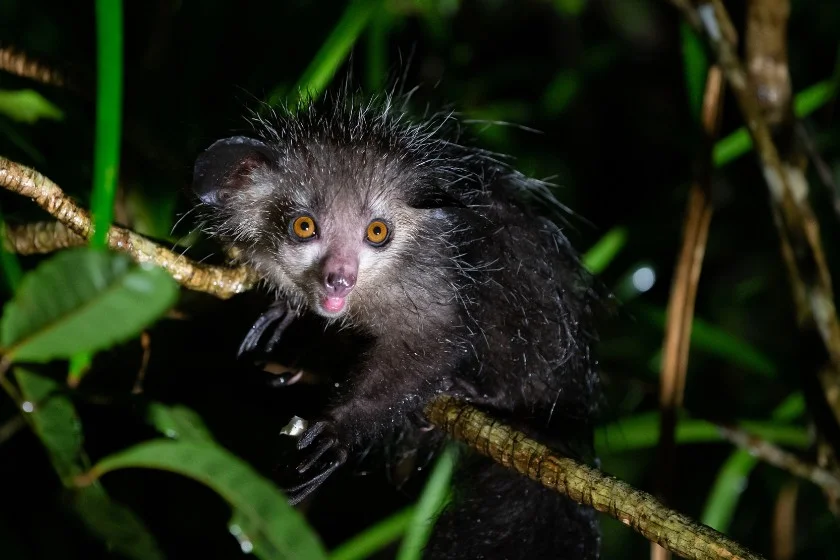
- Scientific Name: Daubentonia madagascariensis
- Where Found: Madagascar
- Conservation Status: Endangered
The aye-aye is a lemur that is a native of Madagascar and is considered the largest nocturnal primate. Its major features are the rodent-like teeth and the thin middle fingers.
It looks disheveled and a bit scary to the casual observer, mainly because of its orange eyes. The thin middle fingers are long, which just adds to the unusual nature of the aye aye.
The aye aye’s teeth and middle finger are important, though. This primate uses the three other fingers to tap a tree trunk in search of prey.
Once it finds suitable prey, it uses its teeth to cut through the wood. The final step it takes is to stick in the middle finger to get the insects.
Best places to see the aye-aye:
- The island of Madagascar
12. Shoebill
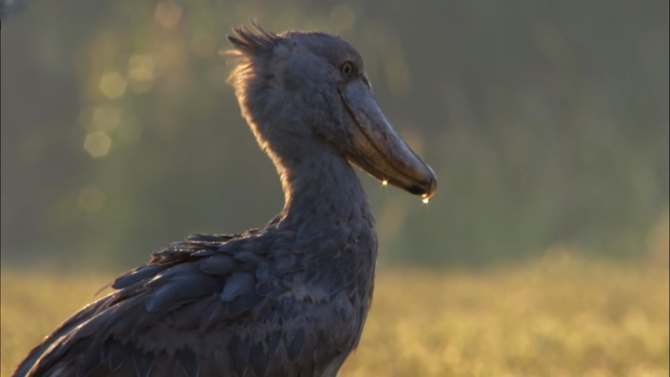
- Scientific Name: Balaeniceps rex
- Where Found: Africa
- Conservation Status: Vulnerable
The shoebill is also known as the whalebill, the shoe-billed stork, and the whale-headed stork. It often inhabits East Africa, especially in places like Zambia and South Sudan.
Its name comes from the shape of the bill, that’s like a shoe. Adults are usually grey, while the younger ones come in brown.
The shoebill doesn’t look ugly to some people, but others find it hard to fancy a grey bird. What’s more, the shoebill is a big bird, more than what one would expect.
It also has its eyes placed at the front of the head rather than the sides, adding to its strangeness.
A crazy fact about the shoebill concerns its childbirth pattern. The first child takes more priority, sometimes to the exclusion of the younger one, who might even be at risk of being eaten by the elder.
13. Blue Glaucus
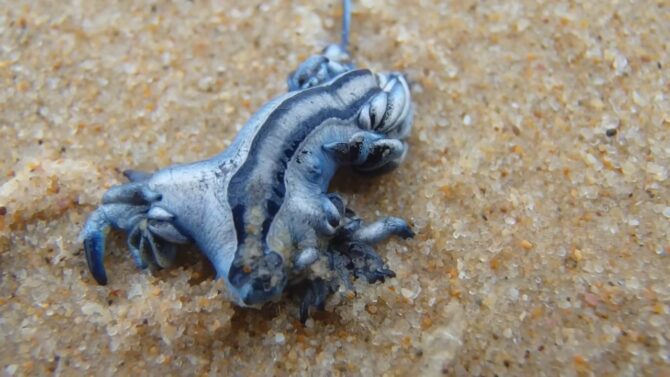
- Scientific Name: Glaucus atlanticus
- Where Found: Worldwide
- Conservation Status: Not extinct
The blue glaucus is striking in its appearance and can be regarded as either admirable or repugnant, depending on the observer.
Because of the latter, we include it on our list. The blue glaucus also goes by other names like the blue sea dragon, the blue ocean slug, the blue dragon, and the dragon slug.
This creature has a flat, tapered body with six appendages. It is usually found in tropical or subtropical areas and will swim to the surface because it stores gulped air in its system. It often feeds on cnidarians.
14. Sea Pigs
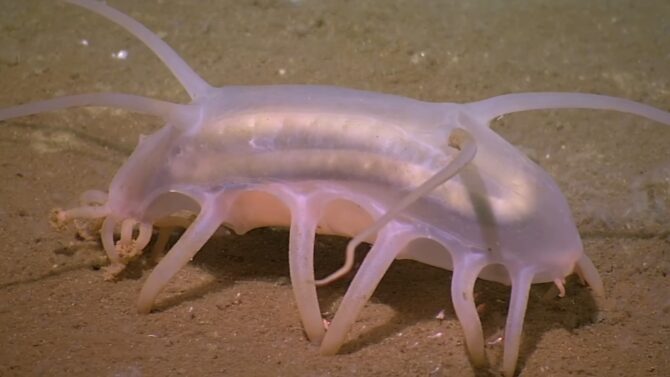
- Scientific Name: Scotoplanes
- Where Found: Atlantic, Pacific, Indian
- Conservation Status: Not evaluated
The sea pig is also sometimes called the sea cow, and it refers to a group of species that fall under the Scotoplanes genus.
Sea pigs live under the Atlantic, Indian and Pacific oceans. They live as deep as 5,000 meters. Because of their environment, not much is known about them, making them a big mystery.
What we do know is that their looks can leave you with goosebumps and not the good kind.
Sea pigs are considered one of the ugliest animals in the world, though they are so tiny and far away that you might never see them.
Another piece of information we have on sea pigs is their social lifestyle. They live in large groups, some numbering up to thousands while others may be set at a hundred.
They also have a protective mechanism to deflect predators. The sea pigs use a chemical substance called holothurin, which is poisonous to other animals.
Best places to see the sea pig:
- Underneath oceans
15. Sea Lamprey
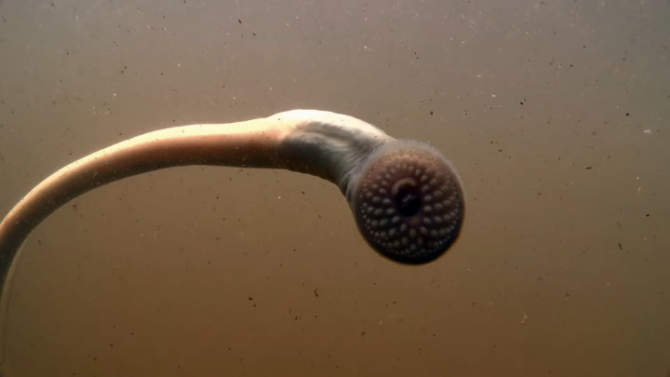
- Scientific Name: Petromyzon marinus
- Where Found: Northern Hemisphere
- Conservation Status: Near Threatened
The sea lamprey is also sometimes called the “vampire fish”, and it is a parasitic lamprey that is native to the Northern Hemisphere.
It does look like an eel vampire and is a good inspiration for a horror movie. The sea lamprey has a scary appearance, earning its place on our list.
Its outstanding physical traits are the body without paired fins, a jawless, round mouth, with sharp teeth all, arranged in a circle.
While it looks like a snake and lives in aquatic environments like a fish, the lamprey is neither a snake nor a fish. It is rather a cyclostome.
As we pointed out above, lampreys are parasites. They attach themselves to fish, which spells bad news for the host. This creature can end up infecting its host.
Best places to see the sea lamprey:
- Atlantic ocean
- Mediterranean sea
- Great lakes
- Black sea
16. Kakapo
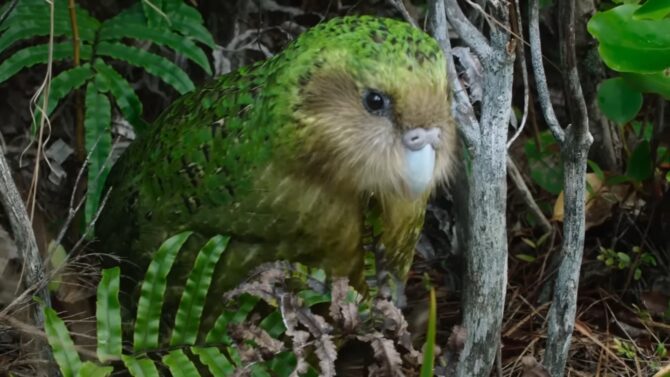
- Scientific Name: Strigops habroptilus
- Where Found: New Zealand
- Conservation Status: Critically Endangered
The kakapo is also known as an owl parrot because of its resemblance to the owl. It is a parrot species that belongs to the family Strigopoidea and can be found only in New Zealand.
It immediately differentiates from other parrot species by being flightless and nocturnal. Then there’s the look.
While other parrots are considered attractive, the same can’t be said of our fauna friend. For starters, it is larger than others of its kind.
Its looks also seem like the result of breeding an owl with a parrot. What it lacks in looks, it makes up in some other traits.
One such trait is the sweet smell it emits. The kakapo smells like flowers and honey, so all hopes of attractiveness aren’t lost for this bird. It is also a gentle creature, which sometimes leaves it defenseless against predators.
The kakapo is critically endangered due to human activities. There’s an estimate of about 200 left.
Best places to see the kakapo:
- New Zealand
17. Proboscis Monkey
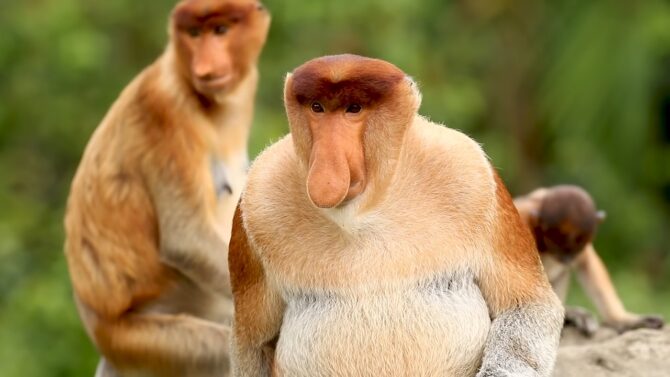
- Scientific Name: Nasalis larvatus
- Where Found: Indonesia
- Conservation Status: Endangered
The proboscis monkey is endemic to Borneo in Indonesia, where you can find it in mangrove forests and coastal areas.
It is an old-world monkey, and similar to others of its kind, it lives on trees. Its defining feature is a long nose, which earned it the alternative name long-nosed monkey.
Monkeys are not known for their beauty, so it isn’t a surprise to have the proboscis on this list. That said, it is more unusual than the standard monkey, starting from the size.
The proboscis monkey is very large, and it has a reddish-brown skin color that’s unique to it. Males have longer noses than females, and it might help in the mating process.
Best places to see the proboscis monkey:
- Borneo, Indonesia
18. Horseshoe Bat
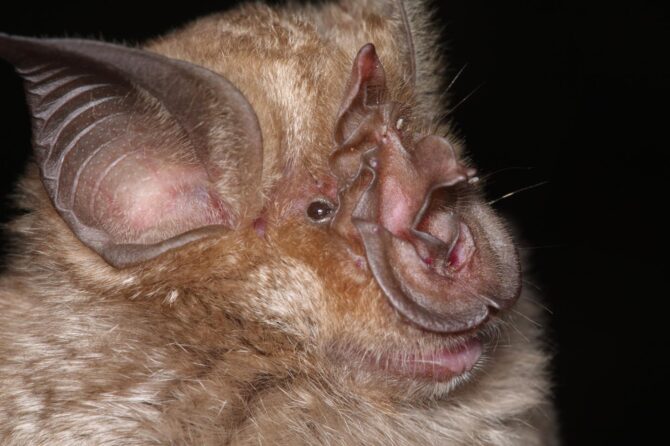
- Scientific Name: Rhinolophus
- Where Found: Africa, Asia, Europe, Oceania
- Conservation Status: Not extinct
The horseshoe bat falls under the family Rhinolophidae and is classified as part of the existing genus Rhinolophus.
There was a second genus under the family, but it has since gone extinct. The horseshoe bat has a wide range, going from Africa to Oceania. It often inhabits buildings, caves, foliage, and tree hollows.
It gets its name from the nose, which is shaped like a horseshoe. This gives it a strange look, even more than what you’d expect from a bat.
Similar to others of its kind, the horseshoe bat relies a lot on sound to communicate. Their looks notwithstanding, the horseshoe bat is useful to humans as food and for healing purposes.
Best places to see the horseshoe bat:
- Tropical and temperate regions from Asia to Oceania.
19. Marabou Stork
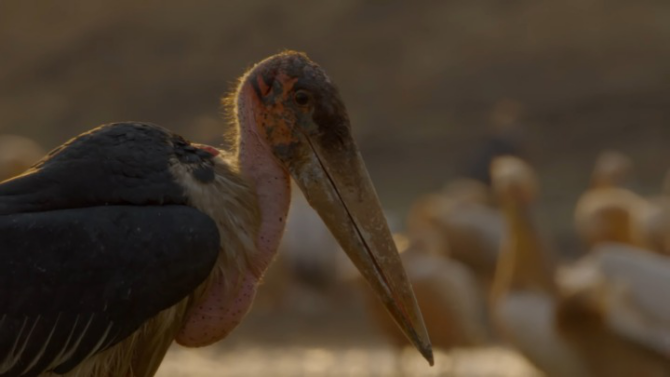
- Scientific Name: Leptoptilos crumeiner
- Where Found: Africa
- Conservation Status: Least Concern
The Marabou stork is a member of the Ciconiidae family, and it;s one of the ugliest birds in the word, I
nhabits the African continent.
A common nickname it bears is the “undertaker bird” because of its thin white legs and the way its wings and back look like a cloak.
The Marabou stork is often associated with evil because of its looks, and its size contributes to the overall nervousness people have about it.
The head and neck are similar to those of a vulture, and it has very long beaks.
This bird is a scavenger, another attribute it shares with the vulture. It feeds on carrion, eggs, baby crocodiles, and even other birds.
Best places to see the Marabou stork:
- Jungles in Africa
Also, check out this curated list of animals that live in jungles.
20. Titicaca Frog
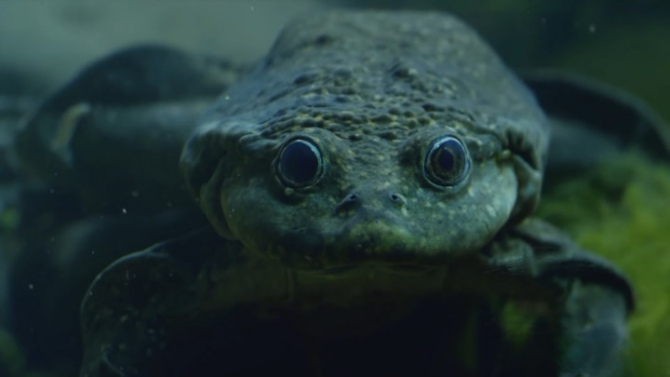
- Scientific Name: Telmatobius culeus
- Where Found: Lake Titicaca basin
- Conservation Status: Endangered
The Titicaca frog is fully known as the Titicaca water frog, and it is a medium to large species in the Telmatobiidae family.
Its name points to the fact that it lives fully in an aquatic environment, and it can only be found in the Lake Titicaca basin.
The Titicaca may be the last on our list, but it is by no means the least ugly. Its flat head, round nose, and large eyes all contribute to making it look odd.
The Titicaca also has a lot of skin, a trait that earned it the nickname Titicaca scrotum frog. A final attribute is its size.
Unfortunately, the Titicaca frog is endangered due to a couple of factors, like pollution and human consumption.
Best places to see the Titicaca frog:
- Lake Titicaca Basin
21. Sphynx Cat

- Scientific Name: Felis catus
- Where Found: Worldwide
- Conservation Status: Not endangered
The Sphynx cat, a result of a spontaneous genetic mutation, is a breed that challenges conventional perceptions of feline beauty. Devoid of the typical fur coat, the Sphynx showcases its wrinkled skin, accentuated cheekbones, and muscular physique.
But beyond its distinctive appearance, the Sphynx cat is cherished for its warm, affectionate, and playful demeanor. Their absence of fur makes them seek out warmth, leading them to become endearing cuddle buddies and frequent occupants of laps.
It’s also worth noting that while they lack fur, their skin can exhibit a myriad of colors and patterns, mirroring the diversity seen in their furred counterparts. This breed, with its unique aesthetics and loving nature, has garnered a dedicated following among cat enthusiasts worldwide.
22. Hyena
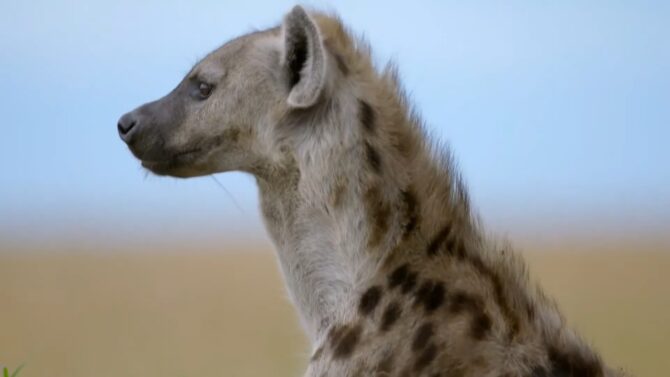
- Scientific Name: Hyaenidae
- Where Found: Africa, eastwards through Arabia to India
- Conservation Status: Not extinct
Hyenas, often misunderstood and maligned in various cultures and media, are fascinating creatures with unique characteristics that set them apart in the animal kingdom. Particularly the spotted hyena, with its unmistakable silhouette marked by a sloping back and sturdy limbs, is a force to be reckoned with.
One of the hyena’s most formidable features is its jaw, which boasts immense strength. This power enables them to break down and consume bones, extracting nutrients that many other predators leave behind.
While they have a reputation as mere scavengers, hyenas are, in fact, proficient hunters. They often hunt in packs and are capable of taking down prey much larger than themselves.
By controlling populations of other animals and cleaning up carcasses, hyenas play an indispensable role in preserving the health and balance of their ecosystems.
23. Chinese Water Deer
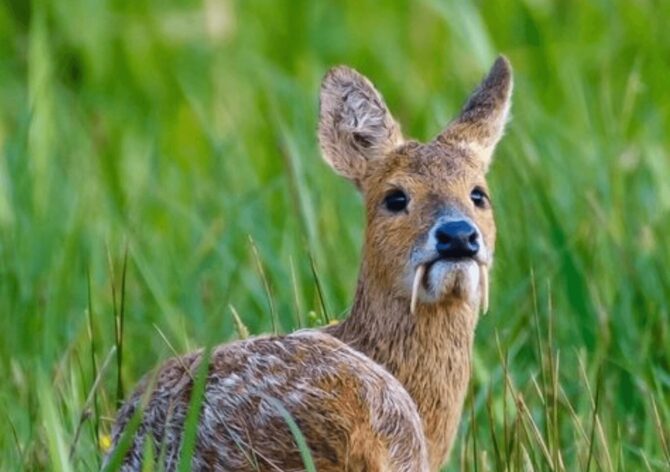
- Scientific Name: Hydropotes inermis
- Where Found: China and Korea
- Conservation Status: Vulnerable
The Chinese water deer, with its petite stature, stands out primarily because of its elongated canine teeth, which eerily resemble vampire fangs. These “tusks” are not for blood-sucking, though.
Instead, male Chinese water deer use them during confrontations to establish dominance and secure territory. Originating from the wetlands of China and Korea, these deer are strict herbivores.
Their diet consists of a variety of vegetation, including grasses, herbs, and plants found in aquatic environments. Their somewhat intimidating dental features juxtaposed with their gentle dietary habits make them an intriguing species.
24. Tardigrade
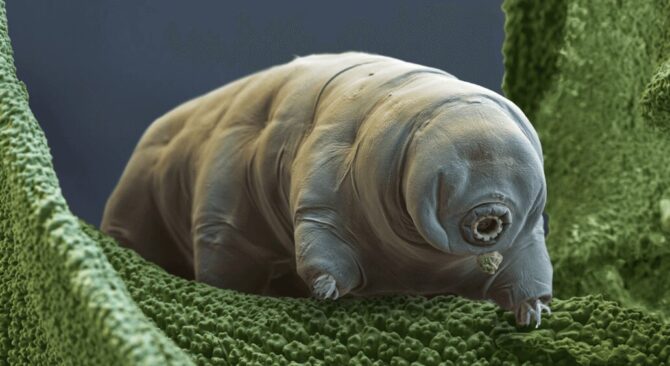
- Scientific Name: Tardigrada
- Where Found: Worldwide
- Conservation Status: Not evaluated
Tardigrades, colloquially known as “water bears,” are microscopic marvels. Their appearance, featuring a segmented body, eight stubby legs, and a peculiar tubular mouth, makes them look like they’ve been plucked straight from a science fiction narrative.
But what’s truly astounding about tardigrades is their unparalleled resilience. These minuscule creatures can endure a vast range of harsh environments.
From the crushing pressures of the ocean’s abyss to the radiation and emptiness of outer space, tardigrades have been found to survive and even thrive. Their ability to go into a cryptobiotic state, essentially shutting down their metabolic processes and reviving when conditions are favorable, is a testament to nature’s incredible adaptability.
